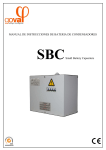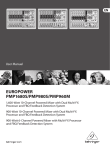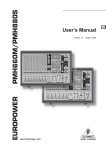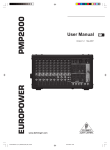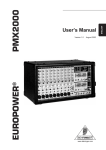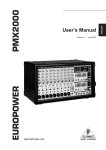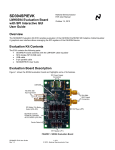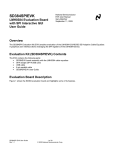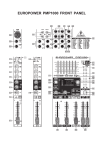Download IB Protector - Popa lichtmasten
Transcript
EUROPOWER MANUAL IB PROTECTOR Pag.1/5 Functional description of the safety relay ‘IB Protector’ 0. Introduction The safety relay IB Protector protects users and appliances against electric failures in a non-earthed mains (IU-mains) through insulation resistance protection. It makes the use of an earth leakage protection redundant. This makes it very useful in combination with mobile gensets because the generator (phase earthing or neutral point earthing) does not have to be earthed by means of an earth pin in the ground. In case a failure occurs, the safety relay IB Protector will disconnect the generator voltage through an external power relay. The insulation resistance between the ground conductor (PE) and the live conductors is measured continuously. The detection threshold can be preset between 30kOhm and 120kOhm. Moreover, several extra functions can be installed: over- or undervoltage, frequency that is too high or too low. These functions can be activated or deactivated by the manufacturer by means of an internal DIP switch. The safety relay IB Protector is equipped with 2 switches. An insulation failure can be simulated by means of a 'test' switch. The safety relay can be activated again through the 'reset' switch. The activation of the power relay can be protected against ‘undesired use’ by means of a secret code. At each start, a self-test is done. First, the power relay is checked (e.g. failure caused by sticking or bridging). Subsequently, an insulation failure is simulated to check the safety relay. 1. Setting the operating functions 1.1 Operation through the front panel Figure 1.3 shows a schematic representation of the front panel. Insulation threshold (insulation level): can be set between 30kOhm and 120kOhm (tolerance ± 10%). 'Reset'-switch: reset after detection of an insulation failure, voltage failure, frequency failure or power relay failure. If the optional protection against “undesired use” has been activated, press the ‘reset’-switch for more or less 5 seconds in order to activate the safety relay (green LED lights up). 'Test'-switch: causes an insulation failure for self-test. Fig. 1.3 Schematic representation of the front panel Datum:16/09/04 Rev.: 01 Uitv:CC Ref: IB Protector-080904rev01-E EUROPOWER MANUAL IB PROTECTOR Pag.2/5 1.2 Functions to be activated by the manufacturer 1.2.1 option “voltage” Voltage protection (standard setting): The lower limit of the voltage is set at 175 Volt. The upper limit of the voltage is set at 285 Volt. The alarm starts when the safety limit has been exceeded during 2 s. 1.2.2 option “frequency” Frequency protection (standard setting): The lower limit of the frequency is set at 42.5 Hz (-15 % of 50 Hz). The upper limit of the frequency is set at 57.5 Hz (+15 % of 50 Hz). The alarm starts when the safety limit has been exceeded during 20 ms. 1.2.3 option “protection against undesired use” The safety relay is delivered with an inactivated protection against “undesired use”. At request (when ordered), this protection can be activated. 1.2.4 option “power relay control” Standard setting: power relay control activated. At request (when ordered): not activated. 2. Description of the failure indications A green and a red LED on the front panel indicate the condition of the safety relay. In case a failure occurs, the red LED shall be activated and the green LED shall go out. The different failure indications through LED combinations can be found in figure 2.3. Fig. 2.3: LED indication when failure occurs Failure code Indication green LED Indication red LED No failures Insulation failure Voltage failure I Frequency failure Power relay failure F on Datum:16/09/04 S C off Rev.: 01 Uitv:CC Ref: IB Protector-080904rev01-E EUROPOWER MANUAL IB PROTECTOR Pag.3/5 3. Operating procedure for failure detection Description Insulation failure Failure code I Voltage failure S Frequency failure F Failure power relay C Datum:16/09/04 Rev.: 01 Actions to be taken 1. When an insulation failure takes place, stop the genset and find the cause of the insulation failure. When the situation is safe again, start the genset again and check whether the insulation failure occurs again. 2. If the insulation failure takes place a second time, disconnect the charge, press the 'reset' button and check whether the insulation failure occurs again. 2.a. If not, there is in insulation failure in the charge: Then you can systematically connect different charges until you find the charge with the insulation failure. Or: disconnect the charges from the genset and check the resistance of each charge between the earth and the mains phase with a multimeter. If you measure a low resistance with one of the charges, then contact the manufacturer of the appliance. 2.b. If it does, then there is a genset or a safety relay failure: contact the manufacturer of the genset. 3. Does the failure often occur? If it does, regulate the insulation threshold in a way that makes it less sensitive, e.g. 30kOhm. 1. Disconnect the charge and check whether the voltage failure still occurs. 1.a. If it does, check the engine speed: when it is too high this will result in overvoltage, when it is too low, this will result in undervoltage. 1.b. If the engine speed is OK, the genset is probably overloaded, which causes undervoltage. Reduce the load or spread it better (in case of a three-phase load). 1.c. If the engine speed is OK and if there is no overload, then there is a genset failure or a failure of the safety relay. In this case, contact the manufacturer of the genset. 1. Disconnect the charge and check whether the frequency failure still occurs. 1.a. If it does, check the engine speed: An engine speed that is too high causes overfrequency, an engine speed that is too low causes underfrequency. 1.b. If the engine speed is OK, it is probable that the genset is overloaded, which results in underfrequency. Reduce the load. 1.c. If the engine speed is OK and if there is no overload, then there is a genset failure or a failure in the safety relay. In this case, contact the manufacturer of the genset. The power relay does not work properly, replace it as soon as possible! Uitv:CC Ref: IB Protector-080904rev01-E EUROPOWER MANUAL IB PROTECTOR 4. Installation, connection scheme and start-up First read the above user’s manual (point 0 - 3). Check the system voltage and frequency. Use only one safety relay for each IU mains. Connect with supply leads (clamp 2 - 13) of min.1mm². Nominal working voltage: - standard: AC 50 Hz 230V - at request: AC 60 Hz 230V Connection scheme (see fig. 3.3): Options A. External LED connection green (2V / 20mA) B. External LED connection red (2V / 20mA) C. External RESET button GREEN D. External TEST button RED Fig. 3.3 Connection scheme safety relay Datum:16/09/04 Rev.: 01 Uitv:CC Ref: IB Protector-080904rev01-E Pag.4/5 EUROPOWER MANUAL IB PROTECTOR 5. Technical data CE Safety relay according to IEC 61557-8 (1997-02). Voltage protection according to IEC 61557-1 (1997-02). - overvoltage category II Own consumption: 1.8 VA max. Rated voltage Un: - AC 50 Hz 230 V Switch component (1 make-and-break contact): - max. voltage: AC 250 V - max. rated current: 8 A - life span: switches > 30x106 - vibration durability: 20 g (30-150 Hz) External output 5-6 and 5-7: max. 2V/20mA Environmental temperature: - 25... + 60 °C Storage temperature: -40...+70 °C Protection: IP 20 Weight: 225 g Insulation co-ordination according to IEC 664-1 (1992-10) - installation category: III - pollution degree: 3 - 'rated insulation voltage': AC 250 V - 'rated impulse withstand voltage': 4 kV Electro-magnetic compatibility (EMC) according to: - IEC 61326-1 (1997-02) - EN 50082-1&2 (also for industrial use) Safety according to IEC 1010-1 (1990-09). Datum:16/09/04 Rev.: 01 Uitv:CC Ref: IB Protector-080904rev01-E Pag.5/5





